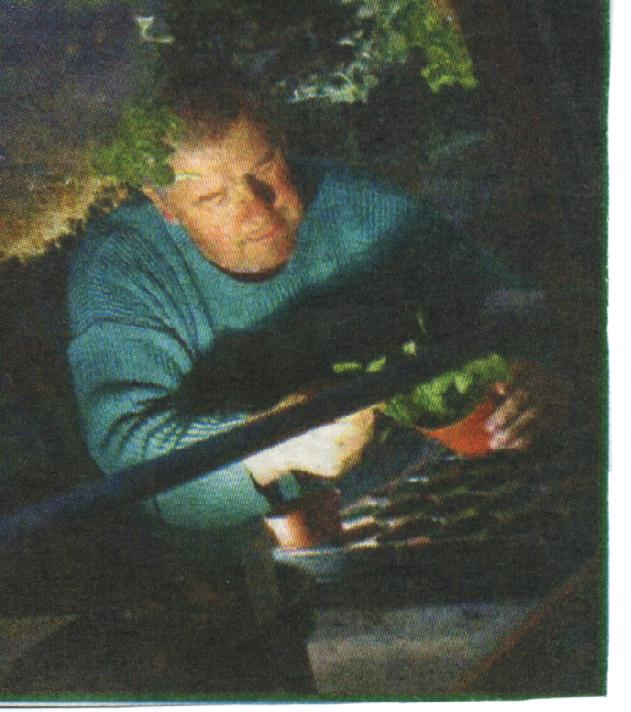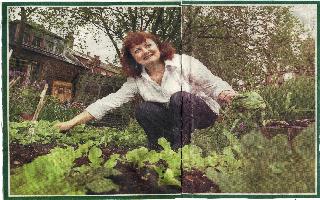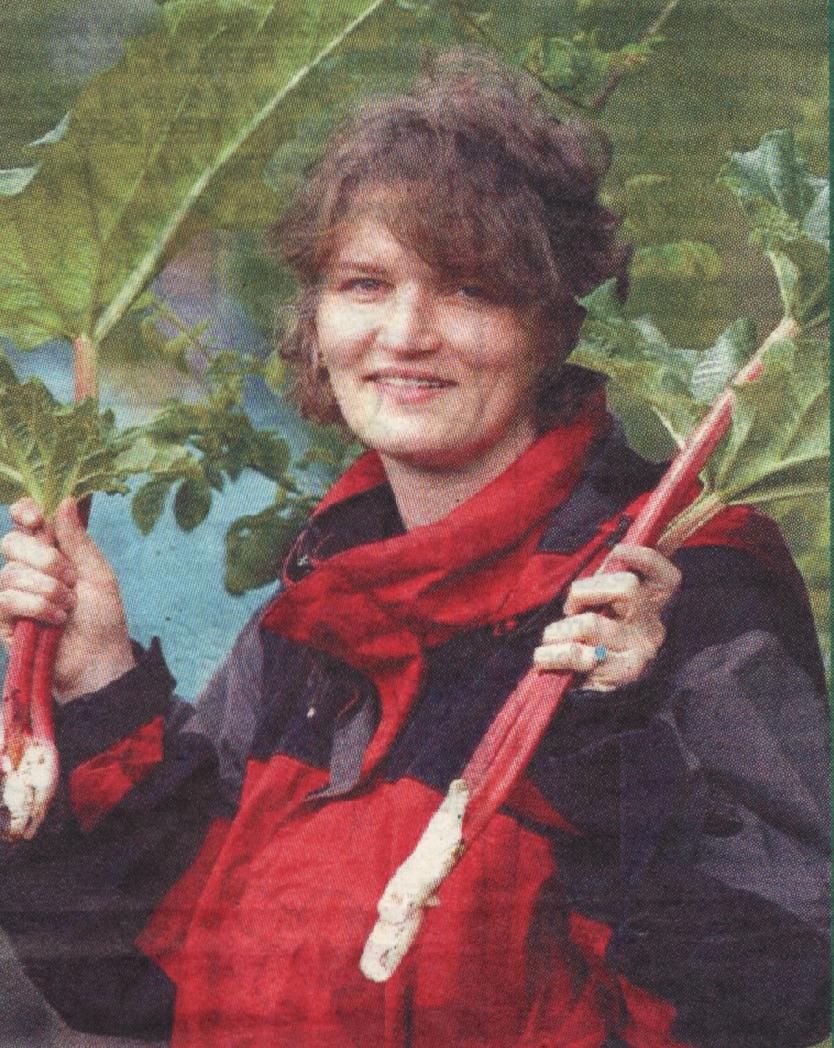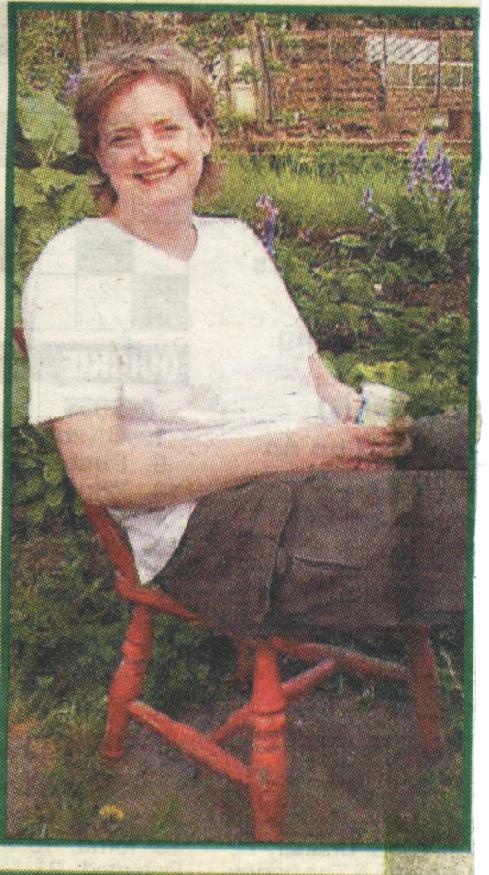YOU MIGHT BE UNAWARE THAT THEY'RE THERE,
BUT GLASGOW'S ALLOTMENTS HAVE NEVER BEEN SO POPULAR...
OR HAD SUCH LONG WAITING LISTS.
By Rosemary Long.
They're the secret gardens
that beckon for thousands of
Glasgow people.
The city's 27 allotments have rarely
been so popular.
Millions of TV viewers remember Arthur Fowler
in East Enders
regularly fleeing to his allotment for peace and quiet in times
of
family crisis.
But many of today's enthusiasts see
them more as an escape from
the fast pace of life and the confines of tenement dwelling -
to say
nothing of the bonus of delicious home-grown potatoes and onions,
freshly-picked peas, lettuce, and tomatoes with real flavour.
Glasgow City Council has 12
allotments in places like Balornock,
Budhill, Springboig, Kelvinside, Queen's Park, Kennyhill.
The other 15 are on ground
privately owned by other bodies such
as the universities, ranging from Maryhill, Merrilee and Bellahouston
to the St John Maxwell allotments at Pollok Park, and Waverly
Residents' Association allotments.
Rentals vary widely. You can
pay just £12 a year for a big plot in
Maryhill, but Lynn Gillespie, at the city council's Land Services,
says:
"I think some privately rented plots can cost an awful lot
more than
that, though they have nothing to do with us."
Waiting lists vary. At places
like Kelvinside, they're long. In many
east end allotments, there's no shortage of empty plots.
But what links them all is the dedication of
the enthusiasts who tend
to their patches of ground, deriving satisfaction and inspiration
from them.
Here, we talk to four such
people as they work in their secret
gardens.
Once you've got an allotment,
you're hooked.
The Fireman.

Once you have your own bit
of land, you're hooked for life,
says Robin Bower.
Secretary of the Queens Park Allotment Association,
he
has toiled happily in his own small kingdom for the last
nine years.
His wife, Linda, jokes that when he's away from
home he
misses his caulis and chrysanths as much as he misses her.
But the family - including his children Jennifer,
11, and
Ross, 8, - benefit greatly from his all-consuming hobby,
eating succulent carrots and broccoli that have a taste that
that is totally absent from the stuff that their neighbours buy
in the shops. "One of Jennifer's friends saw the children
munching peas straight from the pod.
"She was horrified - she'd never seen pea
pods before,"
laughs Robin in one of his two greenhouses.
Allotment greenhouses are very seldom the smart
aluminium
structures seen in garden centres.
They are hand made Heath-Robertson creations,
made out
of stuff found in skips and demolition sites - gloriously patchwork.
He was one of the first to grow flowers in the
Queens Park
allotments, though some in other areas have rules insisting on
a
certain proportion of flowers to add glamour to the rows of spuds
and onions.
Every plot-holder has individual ideas on how
to use the ground.
Some have raised beds, some are militarily precise
with ranks
of obedient seedlings. Others are just higgledy-piggledy.
Inevitably the allotments attract some unwanted
attention - not
just from the teenage vandals who roam Glasgow parks in the
evenings (two greenhouses were burned down recently) - but
from rabbits, squirrels, magpies and fat wood pigeons.
Netting, therefore, can be seen shielding the
crops like giant
green cobwebs.
There are 55 allotments at Queens Park, only
yards from the
flagpole high on the hill, yet you could have walked in the park
for years and never known they were there.
"People come here to chill out. They'll
work on their ground,
but they'll also stop for a cup of tea and a chat," Robin
says.
A few join up with great enthusiasm then, when
the novelty
palls, leave their tract to run to seed and weed.
After a tolerant interval, they are informed
that if they don't
want the space a queue of keen gardeners are waiting for it.
"Programmes like Ground Force have created
a huge interest
in city gardening," Robin says.
"Most week's we get a few inquiries from
people who want
put on our waiting list."
Charges until recently were an amazingly low
£6.50 a year.
That's gone up now but is still reasonable at
£26, plus £3 to
the association for general upkeep.
On one side you'll see a few small beds of plants.
They're operated by the Coach House Trust for
young people
with social problems - growing things is a great way to get to
know yourself.
I feel so close to nature when
I'm here.
The Artist.

Christine Ironside says it's
the beauty of growing things which
lends enchantment.
"I grow mostly flowers, but also fruit,
vegetables and herbs in
an artistic, aesthetic way. I grow things to paint," she
says.
"We have birds nesting here, foxes, and
last year a flock of
very rare birds. I feel very close to nature when I'm here. I
couldn't
live without a garden."
The allotments at Kelvinside, where artist Christine
has gardened
for 18 years, have 75 people on the waiting list and the average
waiting time is from three to six years.
Flowers feature in many of her paintings and
her colourful
landscapes sell for £300 to £1000.
She says: "I am quite fanatical about my
garden. I go there almost
every day."
That's the way Glasgow's secret gardens seem
to affect people.
You feel that you're a million
miles away.
The Scientist.

Susan Waldron has the perfect
answer when stress builds up in
the laboratory at Glasgow University.
The environmental researcher visits her allotment
and spends a
couple of hours digging, hoeing, and raking.
She and her partner, Fin Stuart, live in a tenement
and spend
their days in university labs and offices.
Their acquisition of an allotment a year ago
changed their lives.
Both had been brought up with gardens and missed
them terribly.
"Now we have broad beans,and red onions,
parsley and potatoes,
and we're trying for watercress.
Our first harvest was pretty successful,"
says Susan.
She and Fin work on the plot one full day at
weekends and
occasional evenings. "It's lovely. The birds sing and you
feel you
are miles from the city."
Allotments bring out the best in people. They
come in their old
clothes and boots and poke about at their compost heaps
scrunching leaves in a tube to press out natural liquid fertiliser,
pull up sticks of rhubarb for pies and crumbles.
And for a while shut out the rest of the world.
It's a great escape when you're
stressed.
The P.A.

Penny Dougray is a P.A. in
the finance department of a radio station,
but can be found most evenings in Maryhill coaxing on her beans
and
parsnips.
Penny only developed this urge to cultivate
the soil three years ago
when she was 39.
"I'd never thought of gardening before
but I met someone with an
allotment and suddenly it seemed like something I wanted to do."
She applied to several associations and got
her name on some
waiting lists. The massive Maryhill allotments, off Garscube Road,
were the first to find her a place.
"I spent the first few weeks, morning,
noon and night, weeding. But
now I'm completely dedicated.
"Nowadays we are all ages, a microcosm
of society and we always
have a great laugh."
She added: "It's manual work but there's
no pressure. It's great
when you are feeling stressed."




